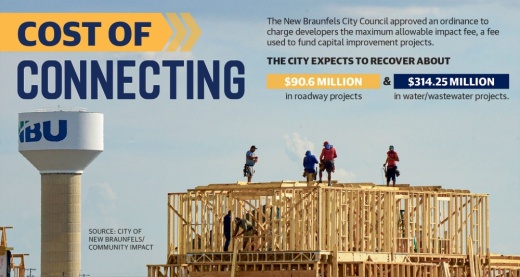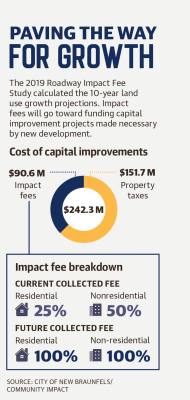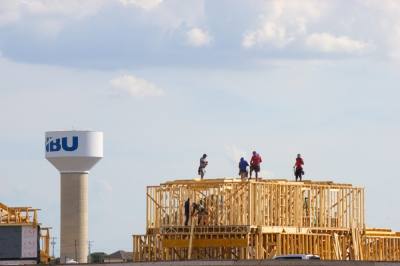In 2020, 66.8% of the developable land in New Braunfels city limits had been built out; by 2025, the number is anticipated to reach 73.5%, according to the city. The increased development of the Hill Country region can be attributed to the rise in population as New Braunfels saw a 56.8% increase in population from 2010-20, according to the U.S. Census Bureau.
After an extensive study and review process, on Nov. 14 the New Braunfels City Council approved charging developers the maximum allowable amount for CIPs, made necessary by new development by setting higher roadway, water and wastewater impact fees. “The impact fee is actually an assessment of new development to generate funding for improvements that are required by new developments,” said Garry Ford, transportation and capital improvements director for the city of New Braunfels. “In other words, it’s new development paying for new development.”
Impact fees are an assessment of new development to generate revenue for funding improvements to new development. Projects that may be funded through developers paying roadway impact fees include widening roads, installing traffic signals and installing turning lanes. By paying water and wastewater impact fees, developers help fund the cost of projects such as new water towers, drainage and wastewater infrastructure.
The maximum impact fee increase will assist in recovering the cost of an estimated $314.25 million in water and wastewater infrastructure projects and $90.6 million in roadway infrastructure projects needed to serve new development in the next 10 years.
City councils across the state can make a policy decision to collect up to 100% of the impact fees. The fees are reviewed every five years in accordance with Chapter 395 of the Texas Local Government Code. The city and NBU will be charging developers the full amount allowed under state law to fund CIP projects attributed to growth, funds from current taxpayers will still contribute to the projects.
“Impact fees are used to help pay for growth, for the capital projects that are attributed to growth,” said Dawn Schriewer, New Braunfels Utilities chief financial officer. “So at New Braunfels Utilities, we have to make sure we have the capacity to serve the growth that’s coming. We have to make sure our water treatment plants, our wastewater treatment plants, our pipeline that we have enough elevated storage, etc., that we have the capacity to serve the growth.”
Curbing roadway costs
The new roadway impact fee charging the maximum allowable amount will go into effect for new developments within city limits with final plat approval on and after March 1 at 100% of construction projects attributed to new residential and nonresidential developments. Most recently, the city was collecting 50% of the nonresidential and 25% of the residential fee, according to Ford. “In years past we’ve only collected a percentage of the impact fee, the city council can make a policy decision to collect anywhere from zero, no impact fees, all the way to 100% and they decided on 100%,” Ford said.
Ford said solving transportation congestion and the quality of roadways in New Braunfels has been a major item for the city based on community feedback. The city considered $161 million in transportation projects to be placed on the upcoming May bond.
“We have many needs in transportation and are just looking for ways to fund those and a lot of these needs are based on new development,” Ford said. “The roadway impact fee program would help support a number of these projects, and actually they have been supporting projects ... since the program has been in place.”
Transportation projects around the city partially funded by the roadway impact fees include Barbarosa Road and FM 1101 intersection improvements and Common Street and Old FM 306 traffic signal and turn lanes.
Preliminary designs anticipated to be funded through roadway impact fees include Common Street from Loop 337 to FM 306, Conrads Lane, Solms Road from I-35 to FM 482 and Orion Drive from Goodwin Lane to the city limits. Partial funding may also go toward citywide intersection improvements, according to the city.City officials decided it was time to increase the fees for developers to help fund the large number of projects that have accumulated in New Braunfels.
Improving water infrastructure
As part of the 2021 Water and Wastewater Master Plan update, CIPs were developed for NBU to serve projected growth through 2045. The recommended impact fee-eligible improvements will provide the required capacity to meet projected water demands and wastewater infrastructure through 2032, according to NBU.NBU worked with consultant Freese and Nichols to calculate water and wastewater fees by looking at land available and projected development over the next decade. The new maximum allowable fees will go into effect for new approved developments on and after Feb. 1 or for which platting is not required. Only utility improvements that serve future growth are eligible for impact fee collection, according to NBU.
“Our board made the decision to have growth pay for growth where it could. I will say that even charging the impact fee, you’re still not pulling in every project cost,” Schriewer said. “And some of that growth falls onto the ratepayers, but if you’re not having growth pay for growth, then that is going to fall onto your existing ratepayers. So our board has taken the stance that they feel like growth should pay for growth where it can.”
NBU has over $800 million in water and wastewater projects that impact fees could partially fund in the next 10 years, which includes the $113 million Guadalupe-Blanco River Authority Mid-Basin Water Supply Project.
The project is intended to meet the projected water needs of the growing population along the I-35 and SH 130 corridors. The project is designed to employ a combination of surface water, groundwater, off-channel storage, and aquifer storage and recovery to efficiently manage a new regional water supply, according to GBRA.
“We’re purchasing water from GBRA, but we have to build infrastructure to get that water,” Schriewer said. “So that is a big portion of the water impact fee is that infrastructure to get that water to NBU, and that water is the source of new growth.” Schriewer said through the process, NBU staff met with developers to receive feedback.
Real estate realities
The New Braunfels housing market has been competitive. As of December, the median price for a home in New Braunfels was $380,253, an over 11% increase from 2021.
The local housing market has an average of 3 1/2 months of housing inventory, but Stephanie Ryan, the board president of the Four Rivers Association of Realtors, said a healthy market has closer to six months of inventory, which indicates a housing shortage in New Braunfels.
Ryan said real estate agents are worried the increase will worsen the housing affordability crisis in New Braunfels and that developers will pass the cost along to homebuyers. “We don’t really love using these impact fees to fund things,” Ryan said. “I mean, there is a cost for all of these things, more water, more sewer. All of these things are definitely being impacted by this influx of people. But we feel like there must be a better way and that it can really have a huge impact on the affordability of the area.”
Jordan Matney, assistant city manager of New Braunfels, said it is hard to predict if development will slow down with the increase in fees due to the upward trend of growth in the area.
“I think that it’s important to make sure that development pays for itself,” Matney said. “I don’t think that should be a burden on our existing taxpayers. ... With the growth that we’ve seen, with the number of permits that we see every single year, I would be surprised if [development slowing down] were to happen.”
Jonathan Packer, president of the Greater New Braunfels Chamber of Commerce, said there are several factors in the economy that could slow down development.
“I think the cost of doing business is very clearly a factor for whether projects can work in a community, and whether it’s inflation or the current interest rate environment, projects are just having a more difficult time gaining momentum,” Packer said. “I’m sympathetic to the public sector; they need to ensure that they’re simultaneously planning strategically for the future and being fair to existing residents. So I think time will tell; [impact fees are] definitely an important factor, but it’s also not the only factor.”









